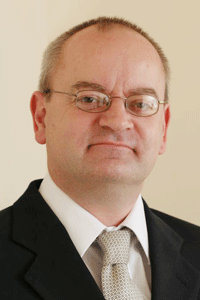No small achievements for the CENR leader!
September 4, 2014

Dr. Jamie Lead
3 patents.
2 impressive years as chair of the SmartState Center for Environmental Nanoscience and Risk (CENR).
1 prestigious international conference being held in Columbia, S.C.
The man behind these achievements is Dr. Jamie Lead, who joined the faculty of the Arnold School of Public Health in September 2012 to develop the CENR, a collaboration between USC’s Arnold School and the College of Arts and Sciences' NanoCenter. The center is part of the SmartState Program, established by the S.C. General Assembly with funds from the S.C. Education Lottery.
Lead’s impact since his arrival from the University of Birmingham in England, where he was director of the Facility for Environmental Nanoparticle Analysis and Characterisation (FENAC), has been huge, especially since his research focuses on understanding nanoscale phenomena in the environment.
More than 125 of the world’s leading researchers in the field of nanoscience will be in the Palmetto State for the 9th International Conference on the Environmental Effects of Nanoparticles and Nanomaterials. The conference runs Sept. 7 - 11 at the Columbia Metropolitan Convention Center, only a few blocks from the Arnold School.
Between phone calls and plans for the conference, Lead said the CENR is now well-established at the Arnold School.
“We’ve published extensively, we have three patent applications that will have an impact on oil remediation and understanding fundamental nanoscience processes, and we’ve developed a strong research program here,” he said.
Among those working in his Center is Dr. Mohammed Baalousha, a colleague from the University of Birmingham, whom Lead recruited as assistant professor in environmental nanoscience. The lab also has five post-doctoral fellows and six graduate students. Over the summer, students from the S.C. Governor’s School for Science and Mathematics, S.C. State University and Morris College worked with Lead and his research team.
“Their work will contribute to future papers, and the students will be co-authors on our work,” said Lead. “It is important to give students the opportunity to learn about and to contribute to the research that we are doing.”
Recently, two books edited by Lead have been published. “Aquatic Organic Matter Fluorescence,” has been published Cambridge University Press as part of its environmental chemistry series. Cambridge University Press describes the 418-page book as “ … the first comprehensive text on the theory and practice of aquatic organic matter fluorescence analysis, written by the experts who pioneered the research area.”
“Nanoscience and the Environment,” also edited by Lead and published by Elsevier, is the 7th book in the Frontiers of Nanoscience series. The 240-page book is described as covering “all aspects of manufactured nanomaterials and their impact and behavior in the environment. Starting with a general overview of the field, emphasizing key points and background, the book then covers crucial specific areas, including nanomaterial transformations in the environment due to dissolution, aggregation, and other processes, and the modeling of environmental exposure and fate.”
Lead is pleased with the early success of the center.
“We have achieved much in the relatively short time the CENR has been in existence and, now that it is more established, we look forward to further progress in understanding the fundamental science and helping to translate this into sound policy and regulation, improved technological applications which will be beneficial to the South Carolina economy and improved teaching to develop the next generation of scientists in this area,” he said.



_01.jpg)
_02.jpg)